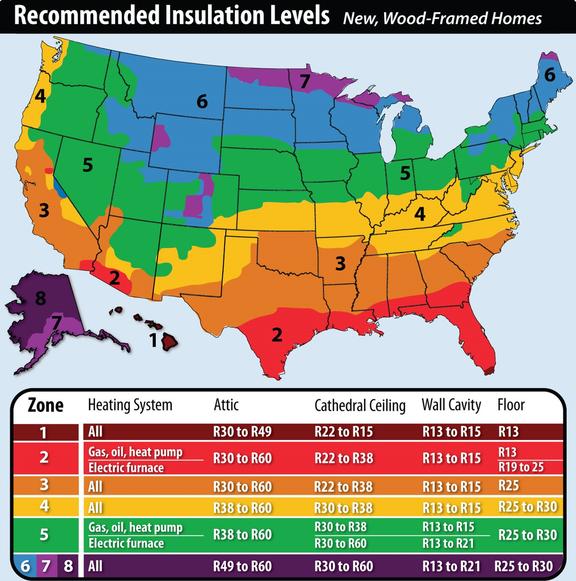Insulation level are specified by R-Value. R-Value is a measure of insulation’s ability to resist heat traveling through it. The higher the R-Value the better the thermal performance of the insulation. The table below shows what levels of insulation are cost-effective for different climates and locations in the home.
 RECOMMENDED INSULATION LEVELS FOR RETROFITTING EXISTING WOOD-FRAMED BUILDINGS
RECOMMENDED INSULATION LEVELS FOR RETROFITTING EXISTING WOOD-FRAMED BUILDINGS
Wall Insulation: Whenever exterior siding is removed on an Uninsulated wood-frame wall:
- Drill holes in the sheathing and blow insulation into the empty wall cavity before installing the new siding, and
- Zones 3–4: Add R5 insulative wall sheathing beneath the new siding
- Zones 5–8: Add R5 to R6 insulative wall sheathing beneath the new siding.
Insulated wood-frame wall:
For Zones 4 to 8: Add R5 insulative sheathing before installing the new siding.
NEW CONSTRUCTION AND ADDITIONS
In most climates, you will save money and energy when you build a new home or addition if you install a combination of cavity insulation and insulative sheathing. Reduce exterior wall leaks by taping the joints of exterior sheathing and caulking and sealing exterior walls. Cavity insulation can be installed at levels up to R-15 in a 2 inch x 4 inch wall and up toR-21 in a 2 inch x 6 inch wall.
These help to reduce the energy that would otherwise be lost through the wood frame. The table below shows the recommended combinations. For more customized recommendations, see the Home Energy Saver.
Consider products that provide both insulation and structural support, such as structural insulated panels (SIPs), and masonry products like insulating concrete forms.
You should consider attic or roof radiant barriers (in hot climates), reflective insulation, and foundation insulation for new home construction. Check with your contractor for more information about these options.
